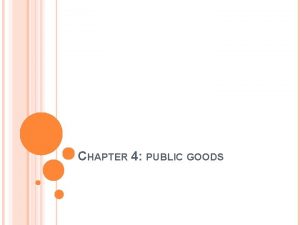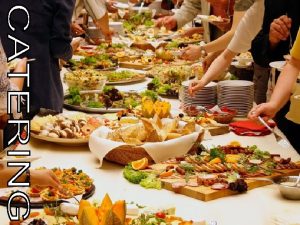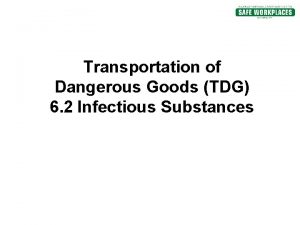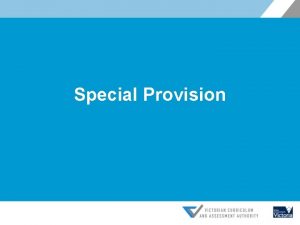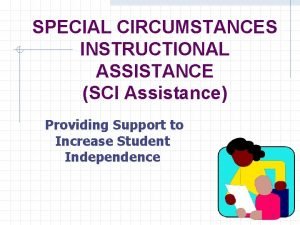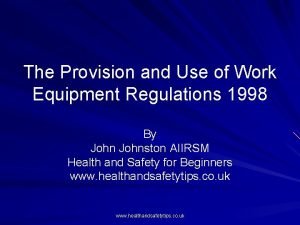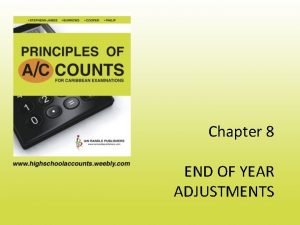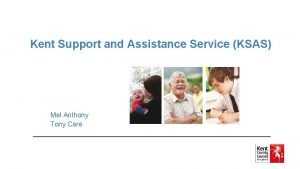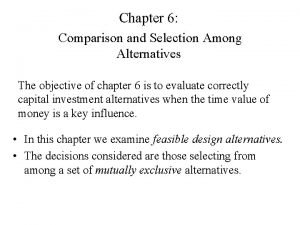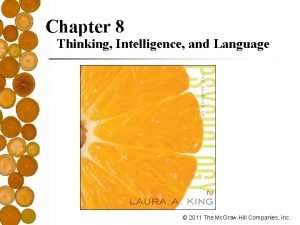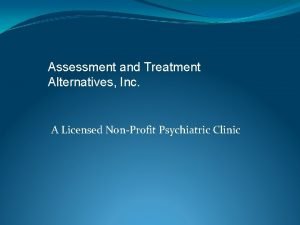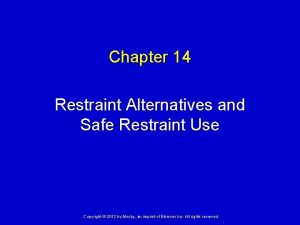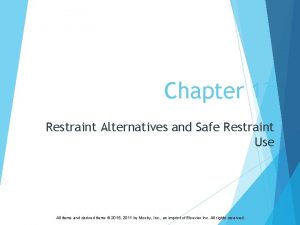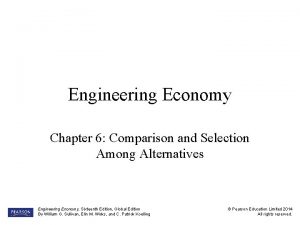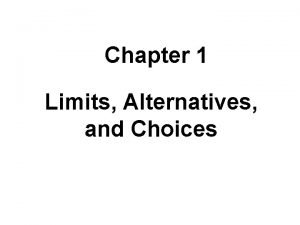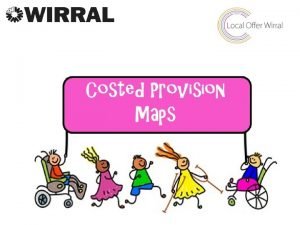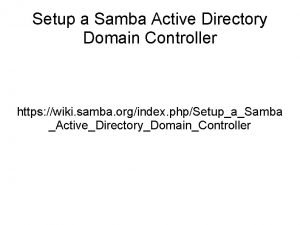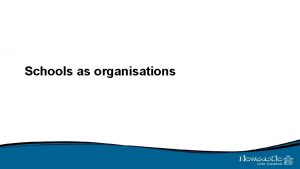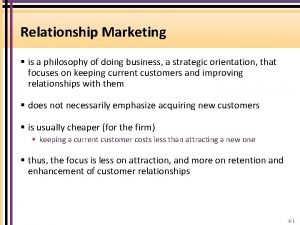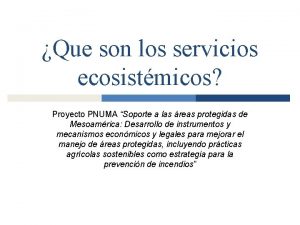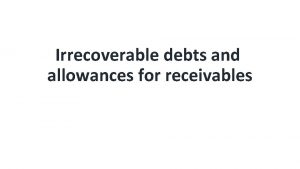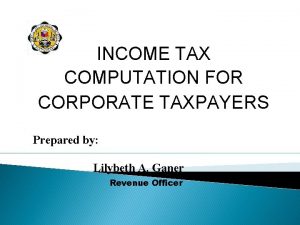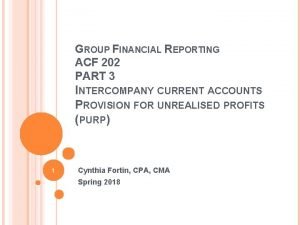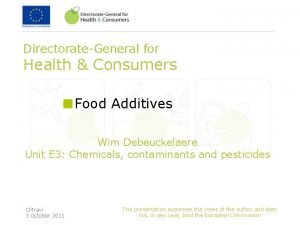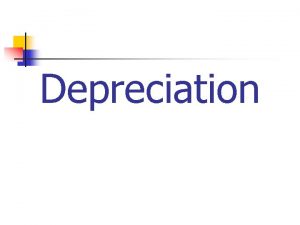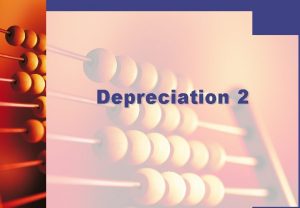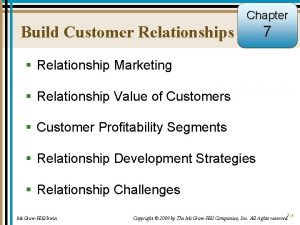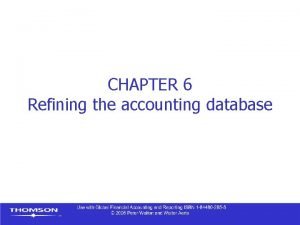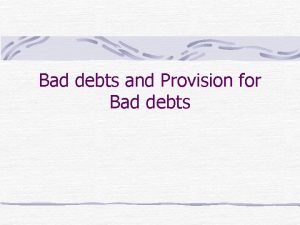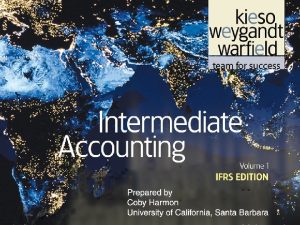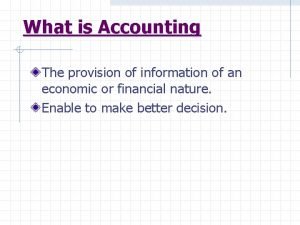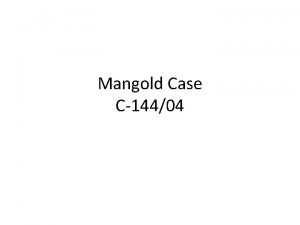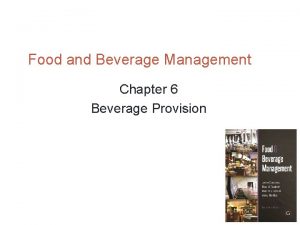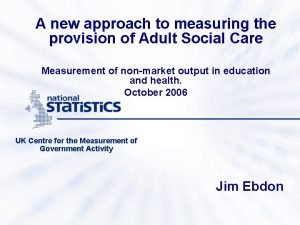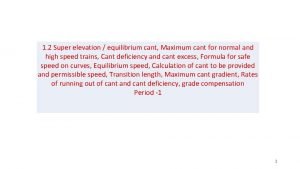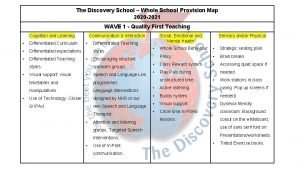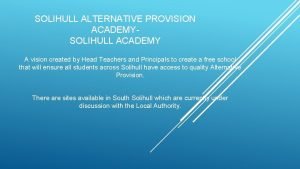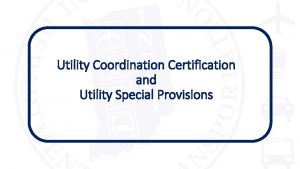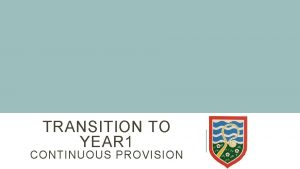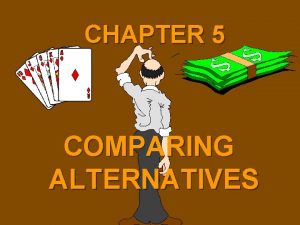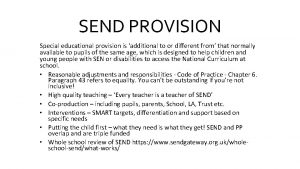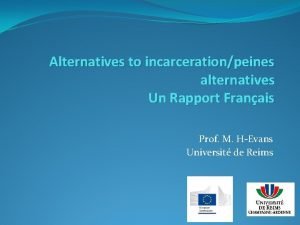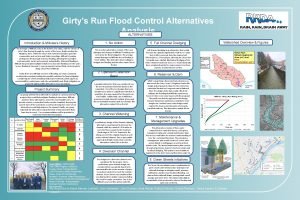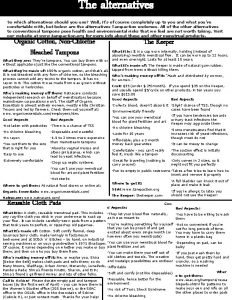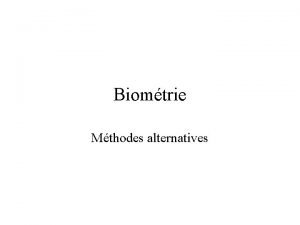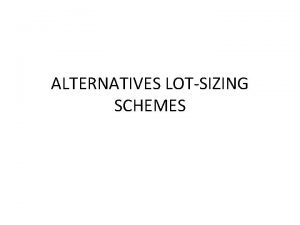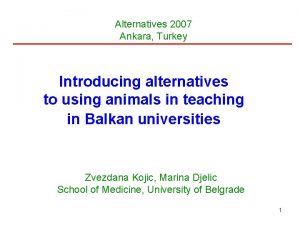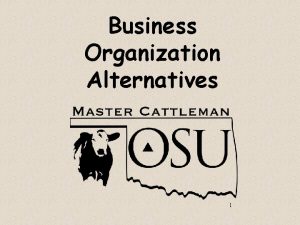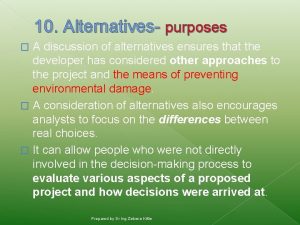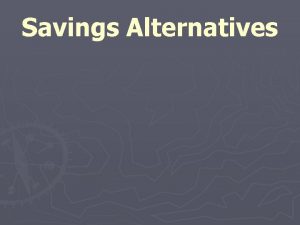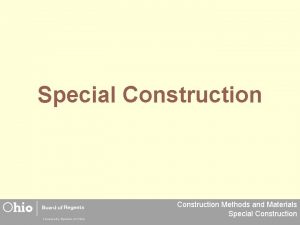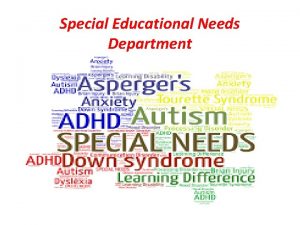Special Assistance Alternatives Provision 1 and Provision 2

















































- Slides: 49

Special Assistance Alternatives Provision 1 and Provision 2

There are “PROVISIONS” (alternate eligibility and meal count systems) THAT WILL HELP TO: ● Reduce administrative burden at the local level ● Reduce paperwork ● Reduce stigma attached to free and reduced-price eligible ● Increase participation

All Provisions Require: Nutrition Services Division Approval by Site!

Provision 1 Overview: Schools with at least 80% of children enrolled for free or reduced-price meals may collect and certify eligibility applications for free students for a two year period.

Provision 1 ● At least 80 percent of children enrolled as of March of the previous school year must be eligible for free or reducedprice meals ● Collect and certify eligibility applications for free students for a two year period.

Provision 1 (continued) ● All other households (reduced-price and paid) must be provided a meal application and be allowed to apply for meal benefits each year. ● Meals do not have to be served free to all students. ● Meal counts must be taken and recorded daily by eligibility category.

Provision 1 (continued) ● Edit checks comparing meal counts by category to attendance adjusted eligibles are required both years. ● Verification must be conducted on a sample of all applications (in year 2 - verification will include a sample of new applications only). ● Reimbursable meal pattern requirements remain the same. ● Site monitoring is required each year.

Provisions 2 Overview: ● Serve meals to participating children at no charge. ● Reduce eligibility application burden. ● Simplify meal counting and claiming procedures.

Feasibility – Is Provision 2 a Good Fit? ● Provision 2 can be a great alternative to an entire school district or a single school within a district. ● Factors to consider in the evaluation process: § § Current participation Potential for increased participation Cost effectiveness of the operation Percent distribution of free and reduced-price eligible students § Because serve all students non-pricing, quicker lines, no stigma free and reduced-price, philosophy of administration

Feasibility – Is Provision 2 a Good Fit? (continued) Financial Feasibility: ● Since Provision 2 is non-pricing, how much revenue will be gained from increased participation? ● How much revenue will be lost from loss of paid and reduced-price payments? ● What will be the cost if paid or reduced-price participation increases? ● Can labor be decreased or diverted to other duties? Labor will be decreased to process eligibility applications and conduct verification, count meals by eligibility category, collect money for paid and reduced-price meals, etc. ,

Feasibility – Is Provision 2 a Good Fit? (continued) See spreadsheets to determine financial feasibility ● Go to http: //www. ohio. gov search National School Lunch Program click on Downloadable Documents scroll down to Provisions ● Nevada financial worksheet

Feasibility – Is Provision 2 a Good Fit? (continued) Determine in Which Specific Situations Provision 2 Might be Feasible: ● District-wide for breakfast and lunch ● District-wide for breakfast only ● In selected schools for breakfast and lunch ● In selected schools for breakfast only

Provision 2 ● Four year cycle (base year plus three years) ● Most effective with high percentage of free and reduced-price eligible students ● Applications collected and eligibility determinations made (including direct certification) during the “base year” or first year of the 4 year cycle

Provision 2 (continued) ● All meals must be served at no charge for entire 4 year cycle unless “delayed implementation” option chosen.

Provision 2 (continued) Delayed implementation ▪ Must be approved by Nutrition Services Division. ▪ Schools may charge students eligible for reduced-price and paid meals in the first claiming period of the base year. ▪ Meal counts for ten days or less in one month may be combined with the following month for the claim for reimbursement.

Provision 2 (continued) Delayed Implementation ▪ Thirty day carryover of eligibility from the prior year may be reduced (i. e. to 10 days) so students will pay for meals sooner and submit eligibility applications. ▪ Following years first claiming period, add meal counts for the base year (not including the first claiming period) to create annualized percentage of free, reduced-price, and paid meals

Provision 2 (continued) During the base year: ● Meal counts must be taken and recorded daily by eligibility category to calculate reimbursement claims. ● Edit checks are required - compare attendance adjusted eligibles to daily meal counts by category.

Provision 2 (continued) ● Percentages of free, reduced-price, and paid meals served during the base year are calculated to claim meals in non-base years (may be monthly or annual percentage, may be by site or group).

Provision 2 (continued) In non-base years (2 nd through 4 th): ● Take total daily point of service meal counts. ● Calculate meals for claiming - multiply total meal count by the free/reduced-price/paid percentages computed during the same month of the base year (or use annual percentages). ● Do not collect eligibility applications for new students.

Sponsor Provision 2 Claim Worksheet-Single Site Agency: FGH District Current Month/Year: 11/10 Base Year: 2004 -05 Meal: Bkfst[ ] Lunch[X ] Apply base year claim percentages for each site to subsequent years’ total meal counts for corresponding month. BASE YEAR 1 Mo. Nov. 2 Base Year Meals Claimed Actual meal counts claimed by eligibility category CURRENT YEAR 3 4 5 Site Claim Percentages Site Total Meal Count Site Meals to Claim by category Free 275 Free % 76. 4 229 Free Reduced 50 Reduced % 13. 9 42 Reduced Paid 35 Paid % 9. 7 29 Paid Total 360 Total % 100 300 Total 300 If the total percentages of free, reduced-price, and paid meals do not equal 100 percent for Provision 2 schools, the paid category must be adjusted to make 100 percent.

Provision 2 and 3 Calculate percentages to two places beyond decimal, then round to one place beyond decimal.

Guided Practice: Determine Meal Counts for Provision 2

Provision 2 (continued) In non-base years (2 nd through 4 th): ● Conduct daily meal count edit checks using total enrollment (do not use free, reduced-price and paid eligible) ● Multiply total enrollment times attendance factor (94. 4% for 2010 -2011) for attendance adjusted eligible. ● Compare attendance adjusted eligible to total daily meal counts.

PROVISION 2 MEAL COUNT EDIT CHECK Agency: _______Jefferson Elementary School_________ Current Month/Year _February 2011 Breakfast [ ] Lunch [ X ] Multiply the total enrollment by the current attendance factor to arrive at the attendance adjusted enrollment. Next, compare this to the total number of meals claimed daily. Provide an explanation for each daily meal count that exceeds the attendance-adjusted enrollment. Date 2/1/11 Total X Enrollment 250 Attendance Factor 94. 4% = Attendance. Adjusted Enrollment Total Daily Meal Count 236 225 2/4/11 219 2/5/11 238 Explanation/ Comment Pizza

Guided Practice: Determine Meal Count Edit Check for Provision 2

Provision 2 ELIGIBILITY Worksheet. Single Site ● Meal counts by category cannot exceed the number of free, reduced-price and paid eligible times the number of operating days. ● In non-base years, if there is more than a 5% increase in enrollment from the base year, you should calculate revised number of eligible free, reduced-price and paid students so claims for reimbursement will pass the edit check. ● Changing enrollment by eligibility does not affect meal counts.

PROVISION 2 ELIGIBILITY WORKSHEET SINGLE SITE Agency: Whittle School District Site: Jefferson Current Month/Year: December 2010 Base Month/Year: December 2004 Meal: Breakfast [ ] Lunch [ X ] To calculate the reported eligibility for the Claim for Reimbursement, apply base month/year eligibility percentages to subsequent month/year total enrollment. Total enrollment may be the last operating day of the month or the highest enrollment during the month. BASE YEAR CURRENT YEAR 1. 2. Base Year Eligible 3. Eligibility Percentages Month Actual base year eligibility by category number of base year free, reduced-price, and paid eligible ÷ by total eligible (from column 2) DEC 4. Current Month Enrollment 5. Current Month Eligibility by Category (Column 3% X Column 4) Free 300 Free % 60. 0 450 Free Reduced 75 Reduced % 15. 0 113 Reduced Paid 125 Paid % 25. 0 187 Paid Total 500 Total % 100. 0 750 Total 750

Guided Practice: Determine Eligibility for Provision 2

General Information and Requirements

Provision 2 ● Verification ▪ Performed during base year ▪ Not required during non-base year ● Eligibility applications and direct certification information may not be collected in non-base years or provision status will be lost (unless collecting socioeconomic data for an extension). ● Site monitoring requirements remain in effect to determine correct meal counting.

Provisions 2 ● Can be used for both Breakfast AND Lunch ● Can be used for Breakfast OR Lunch however: A provision used for one meal only requires that eligibility applications must be collected and meal counts taken by eligibility for the non-Provision meal ● Reimbursable meal requirements remain the same.

Provisions 2 ● May implement District-wide Provision claiming for all schools or for a subgroup of schools within the District ● Total meal counts for all sites ● Develop meal count percentages (Refer to NSD Information Sheet # 17 for further details)

Both Provisions Recordkeeping is extremely important! ●All base year documents should be kept on file with current year documents. ●Eligibility applications should retrievable by site.

Both Provisions Recordkeeping (continued) ●Rosters must be kept by month by site. (Very Important) ●Base year eligibility documents must be retained until a new base year is developed and for a minimum of 3 additional years beyond the provision cycle.

Provisions 2 Recordkeeping (continued) ●Make sure to maintain base year socioeconomic data used to request extensions throughout the Provision cycle(s) (maintain same base year even with multiple extensions).

Provisions 2 Request for free and reduced-price data ● Provide base year eligibility by category or percentages (i. e. for Star Testing, No Child Left Behind, e-rate, Outdoor Education)

Provision 2 Changes in School Population May Require New Base Year ● Adding new school with changing attendance area ● Splitting one school to two schools with boundary changes ● See USDA Provision 2 Guidance Manual Questions and Answers, page 36

EXTENSIONS: When Cycle Ends : OPTIONS ● Revert back to standard meal claiming ● Apply for an extension ● Apply for a new base year § Regular § Streamlined (New applications required in both cases)

When Cycle Ends: Establishing a new base year ● Cannot carry-over percentages from the base year for the first claiming period (MB 06 -108). ● All students are paid until an approved eligibility application on file. ● Submit request for provision approval prior to new base year.

Applying for an Extension Establish that school’s income level, adjusted for inflation, has remained stable, declined, or had negligible improvement ● Negligible improvement – 5% or less ● Use pre-approved site-specific equivalent socioeconomic data from base year and last year of current cycle (see extension request). ● See USDA Provision 2 Guidance for example to calculate percentage change.

Extension (continued) Pre-approved socioeconomic data ● Food Stamp direct certification ● Cal. WORKs direct certification ● FDPIR ● Unemployment ● City/county zoning or economic planning

Extension (continued) Another Extension Option ● Determine statistically valid sample of student eligibility by site prior to end of school year last provision year in the cycle. Include § § Direct certification Food Stamps/Cal. WORKs Migrant, homeless, runaway Eligibility applications ● Compare percentage of free and reduced-price eligible to same month in base year

Extension (continued) ● Extensions granted for 4 -year cycle for Provision 2. ● Continue using base year percentages (Provision 2). ● Definition of base year – last school year for which eligibility determinations were made and meal counts taken by type.

Guided Practice: Determine If School Qualifies for an Extension

Streamlined Base Year ● Must § Complete a minimum of one Provision 2 cycle. § Request and fail to get approval for an extension. § Serve meals non-pricing. ● May use enrollment based or participation based base year. § If participation based, must have system to accurately count total meals by eligibility.

Streamlined Base Year (continued) School determines program eligibility for a statistically valid sample of either: ● All enrolled students with access to the applicable meal program as of October 31 or another date approved by the State (enrollment based) OR ● Enrolled students participating in the applicable meal program (participation based).

Streamlined Base Year (continued) ● Statistically Valid Sample § Pool of students limited to enrolled students with access to meal program. § Students must be randomly selected from the sample frame (large enough to be significantly valid). § Response rate to survey must be at least 80 percent. ● See USDA Provision 2 Guidance Manual for details.

Guided Practice: Enrollment Based Streamlined Base Year -Determine Meal Counts for New Base Year

Resources ● California Dept. of Education Web Site http: //www. cde. ca. gov/ls/nu/sn/mgmb. asp ● USDA Provision 2 Guidance Manual http: //www. fns. usda. gov/cnd/Governance/prov-1 -2 -3/Prov 2 Guidance. pdf ● California Food Policy Advocates http: //www. cfpa. net/p 2/home. htm ● http: //www. ohio. gov, search –National School Lunch Program, click on NSLP Downloadable Documents, scroll down to Provision information ● CDE CNIPS web site, downloadable forms
 Public provision vs private provision
Public provision vs private provision Examples of institutional catering
Examples of institutional catering Packing instruction 620
Packing instruction 620 Vcaa special provision
Vcaa special provision Special circumstances instructional assistance assessment
Special circumstances instructional assistance assessment The provision and use of work equipment regulations 1998
The provision and use of work equipment regulations 1998 Closing off the year
Closing off the year Kent support and assistance apply online
Kent support and assistance apply online Export marketing and investment assistance
Export marketing and investment assistance Comparison and selection among alternatives
Comparison and selection among alternatives Ap psych chapter 8
Ap psych chapter 8 Evaluating alternatives and making choices among them
Evaluating alternatives and making choices among them Evaluating alternatives and making choices among them
Evaluating alternatives and making choices among them Assessment and treatment alternatives
Assessment and treatment alternatives Restraint alternatives and safe restraint use
Restraint alternatives and safe restraint use Restraint alternatives
Restraint alternatives Comparing alternatives engineering economy
Comparing alternatives engineering economy Economizing problem definition
Economizing problem definition Costed provision map
Costed provision map Samba ad dc
Samba ad dc Summarise types of early years provision
Summarise types of early years provision Relationship marketing philosophy
Relationship marketing philosophy Servicios ecosistémicos de provisión
Servicios ecosistémicos de provisión Unrealized profit in manufacturing account
Unrealized profit in manufacturing account Qué acto aseguro nuestra salvación
Qué acto aseguro nuestra salvación Irrecoverable receivables
Irrecoverable receivables Provision for income tax
Provision for income tax Interest suspense method
Interest suspense method Provision of unrealised profit
Provision of unrealised profit Provision food list
Provision food list Depreciation motor vehicle
Depreciation motor vehicle Provision of depreciation account
Provision of depreciation account Define the relationship chapter 7
Define the relationship chapter 7 Provision vs accrual
Provision vs accrual Journal entry for provision for bad debts
Journal entry for provision for bad debts What is bills receivable with example
What is bills receivable with example Accounting standard 29
Accounting standard 29 What is provision in accounting with example
What is provision in accounting with example Returns outwards
Returns outwards A provision is
A provision is Beverage provision
Beverage provision Measurement of provision
Measurement of provision Explain equilibrium cant
Explain equilibrium cant The discovery school
The discovery school Solihull ap academy
Solihull ap academy Concepts of primary health care
Concepts of primary health care Utility coordination
Utility coordination Continuous provision year 1
Continuous provision year 1 How does informal care contribute to service provision
How does informal care contribute to service provision Asc 740-10
Asc 740-10
